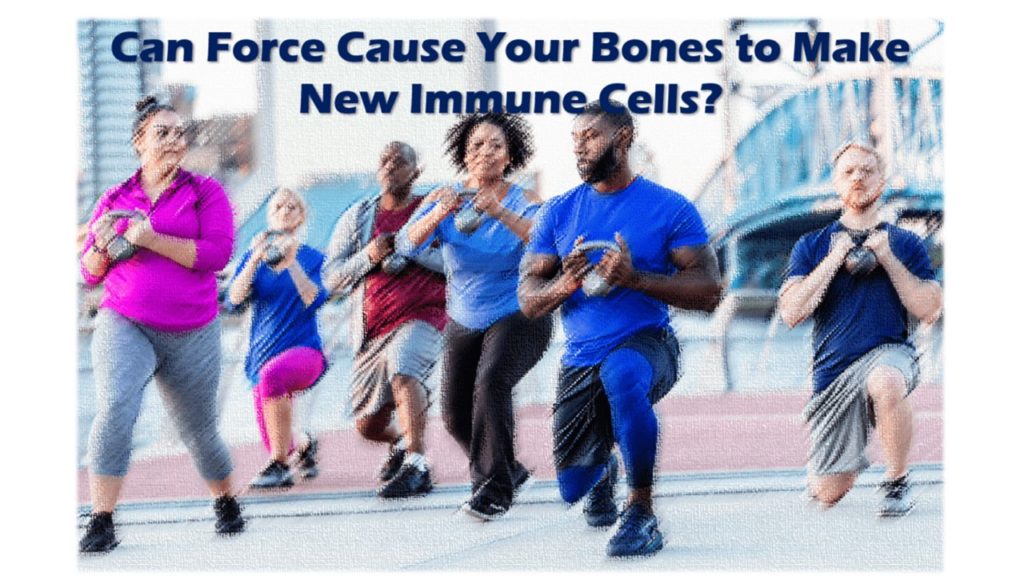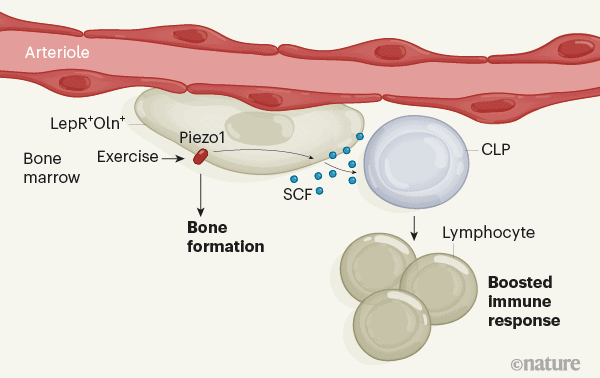Does Exercise Create New Immune Cells in Your Bones?

The more we learn about the body, the stranger and more glorious it gets. Today we’ll explore your bone marrow and how that intersects with a newly discovered process that ties exercise to your immune system. Let’s dig in.
What’s in Your Bone? What Does the Marrow Do?

Many people likely understand the concept that there is something in their bones, but they likely have no idea that what’s in there is a complex mix of cells that help to keep them alive. First, your bone marrow is a cell factory, producing 500 billion new white and red blood cells a day. Next, your bones are structurally supported by trabeculae or small organic-looking supports that give the bone strength and resistance to fracture (above). Inside those little cavities created by those supports is where lots of cells live.
What types of cells live there?
- Hematopoietic Stem Cells (HSCs) that give rise to white blood cells, red blood cells, and platelets
- Mesenchymal stem cells (MSCs) that help repair tissues
- Many different types of white blood cells
- Macrophages-large cleanup cells
- Fibroblasts
- Adipocytes (fat cells)
- Endothelial stem cells
- Osteoblasts (bone-forming cells)
All of these cells are highly interconnected and support each other. For example, if you take out the MSCs, then the HSCs can’t function. This is because the MSCs excrete a chemical that helps to support the HSCs (SCF).
Bone Marrow Concentrate
We have transplanted the patient’s own bone marrow concentrate since 2005 to help patients heal from various orthopedic injuries. This starts with taking bone marrow aspirate and then using various centrifuge techniques to isolate the stem cell containing fractions of the bone marrow. These are rich in both MSCs and HSCs.
Exercise and Immune Cells in the Bone Marrow

We know that our bones get stronger via exercise. Meaning that this stimulates the osteoblasts to turn into mature bone cells. What this team of researchers wanted to investigate was the link between exercise and other bone marrow cells.
The research group placed mice on running wheels and found that running led to a higher number of immune cells (bacteria-killing lymphocytes) (1). The group found that bone-forming cells (Oln+) cells express a protein that can sense force (a mechanosensitive ion channel protein Piezo1). They then showed that lymphocyte numbers are abnormally low in mice that they engineered to lack this protein. Hence, they uncovered a previously unknown pathway by which exercise, sensed through a mechanosensitive protein, triggers Stem Cell Factor (SCF) expression in bone-forming cells to help maintain lymphocytes. Hence, the physical force of exercise is directly linked to immunity.
Implications
As we get older, it’s use it or lose it. Meaning we know that older people who work on building their muscles have muscle tissue that’s more similar to young people. We also know that exercise protects overall health. Now there’s an implication that exercise can also directly impact the immune system.
For patients undergoing bone marrow stem cell procedures, the implication is clear. As much exercise as you can muster before a procedure is the best way to improve your cells. This would be weight-bearing exercise and not cycling. This may also help your immunity and could also have impacts on your ability to fight a post-procedure infection. While these are very rare, do they happen more often in patients who don’t exercise? Only time will answer that one.
The upshot? You now have one more reason to exercise. Your immune health may depend on it!
____________________________________________
References:
(1) Shen, B., Tasdogan, A., Ubellacker, J.M. et al. A mechanosensitive peri-arteriolar niche for osteogenesis and lymphopoiesis. Nature (2021). https://doi.org/10.1038/s41586-021-03298-5

If you have questions or comments about this blog post, please email us at [email protected]
NOTE: This blog post provides general information to help the reader better understand regenerative medicine, musculoskeletal health, and related subjects. All content provided in this blog, website, or any linked materials, including text, graphics, images, patient profiles, outcomes, and information, are not intended and should not be considered or used as a substitute for medical advice, diagnosis, or treatment. Please always consult with a professional and certified healthcare provider to discuss if a treatment is right for you.
